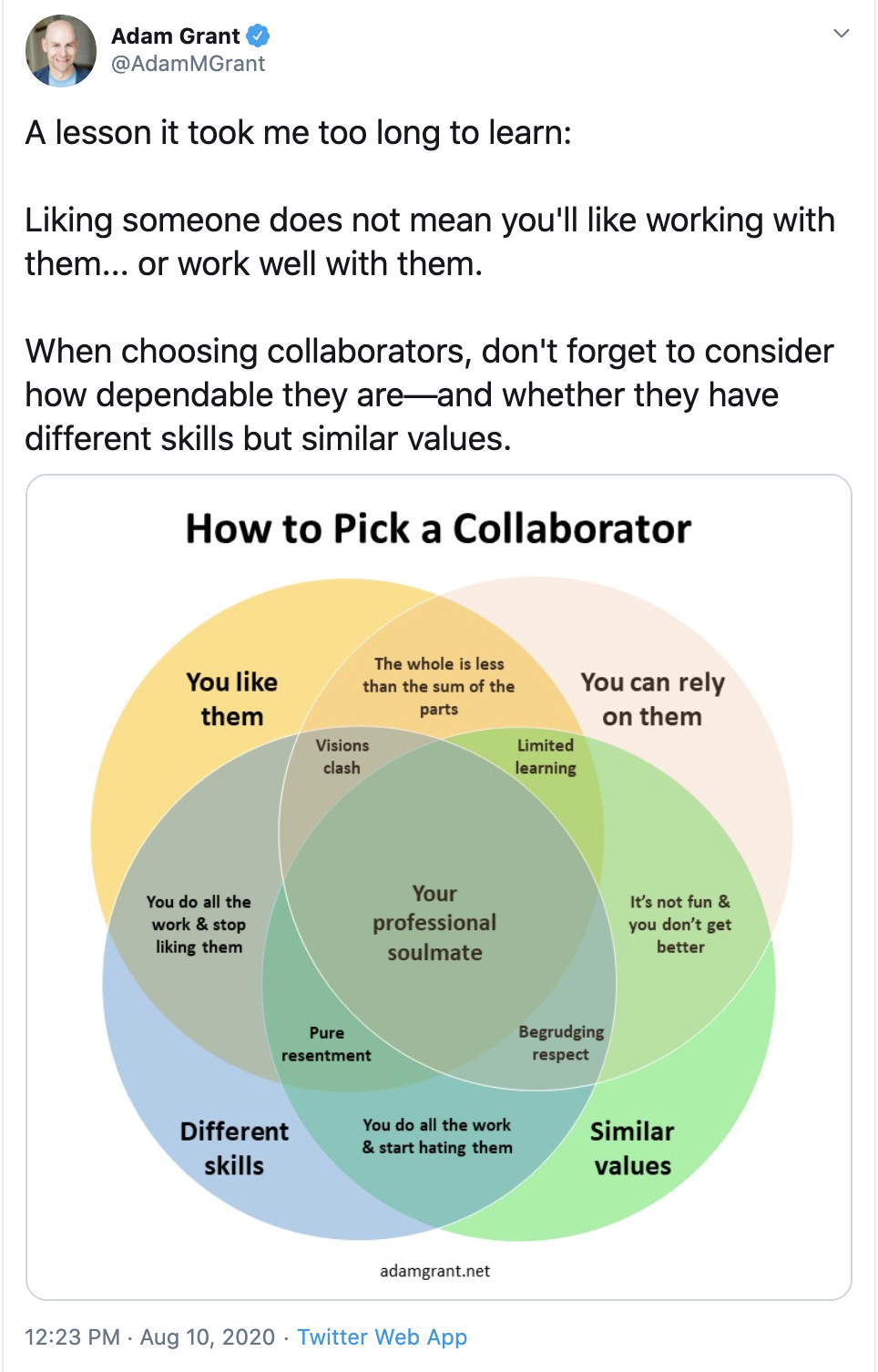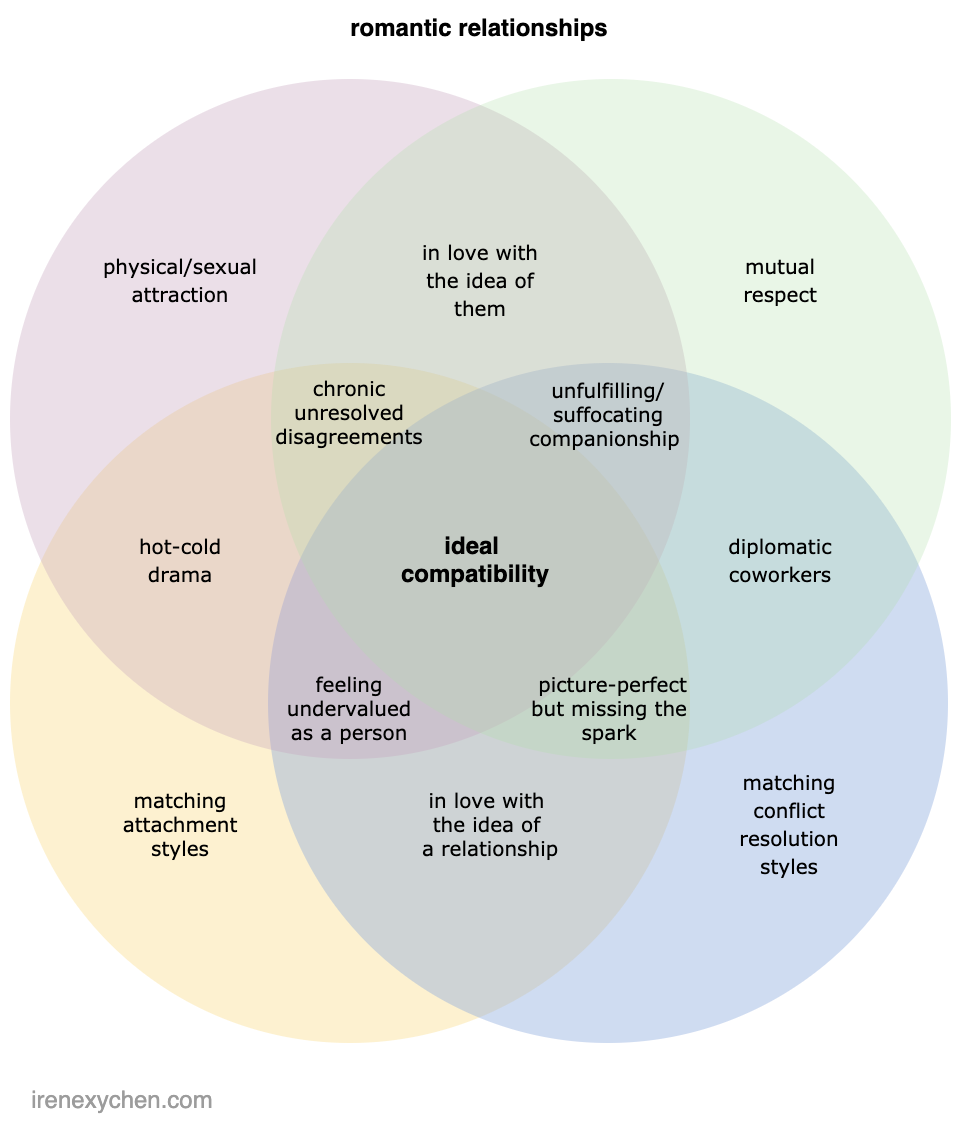Prompted by Adam Grant’s tweet on finding your professional soulmate, I took a moment to think about how the same Venn diagram-style presentation could be used to visualize other relationships.

I decided to do the same exercise by creating the romantic partnership version, with my conclusions drawn from empirical knowledge and personal experiences, as well as second-hand information from observations and testimonies of the people around me.
preluding assumptions
This is under the presumption that both parties are decent people, excludes issues of not having shared interests or emotional connection, since those can be developed depending on how much effort each party is willing to . It also seems fairly likely that both parties actually got to know each other from mutual friends, mutual experiences or mutual hobbies.

difficult-to-change traits
The four quadrants that I ended up choosing individually seem like necessary conditions that are either exclusively satisfied or not satisfied. Unless major events or changes occur, someone attachment style, conflict resolution method, as well as physical attraction and level of respect for one and another don’t seem to be elements that would vary, which is why they seemed like good traits to evaluate that would make or break a relationship.
attachment styles
In reference to Attachment theory from John Bowlby, most people can be bucketed into one of the following four major attachment patterns:
- Secure
- Anxious-Preoccupied
- Dismissive-Avoidant
- Fearful-Avoidant
which can be graphed in two axis: anxiety level, and avoidance level.
It was originally argued that for around 70-80% of the population, attachment styles solidified during early childhood remain generally constant throughout one’s lifespan1 , 2.
Obviously, it seems like one with high levels of anxiety should be paired with someone secure, but the nuances of the lesser straightforward pairings aren’t exactly red flags either.
conflict resolution style
In management, there are five major response styles to conflicts, according to the Thomas-Kilmann Conflict Mode Instrument (TKI):
- Collaborating
- Competing
- Avoiding
- Accommodating
- Compromising
I’ve recently had a few personal conflicts with friends, with resulted in some friction due to my avoidant nature.
With my previous relationship experience with someone of more avoidant nature, small issues were left unresolved until they exploded in your face later on. Eventually, due to lack of resolution, it turned into an accommodating-competing dynamic, leading to a breakdown in communication.
Then, more recently, conflicts within my friend group caused by difficult communication through online mediums, which led to misunderstandings and a lack of accountability, was between a collaborating individual and an avoidant one. Collaborating evolved into accommodating, which further worsened avoidance. In retrospect, it all worked out with enough efforts from both parts, but a mismatch in conflict resolution styles definitely made things more difficult.
Conflict resolution styles also closely ties into personality types and one’s nature. Perhaps similar parallels can be drawn with one’s reaction to stress:
- Fight
- Flight
- Freeze
- Sleep
- Fun
physical & sexual attraction
Seems to be a necessary condition to avoid dead-bedroom situations.
mutual respect
Self-explanatory? Addendum to respect yourself first to become someone respectable; external validation isn’t sustainable.
meta : presentation of information
I’m aware that circles actually can’t illustrate all possible combinations of the four categories, but I personally chose circles since they’re more easier to understand at a glance.
I’m missing “mutual respect + matching attachment styles”, as well as “physical/sexual attraction + matching conflict resolution styles”. The former would likely fall under the “just friends” category.
As for the latter, it seemed like an odd combination of “we’re able to resolve conflicts, but unable to respect each other”? Curiously, the most difficult category that I ended up filling out last was the “physical/sexual attraction + matching attachment styles + matching conflict resolution styles - mutual respect” category. It seemed pretty incredulous to me that you can resolve conflicts appropriately, but not respect your partner.
meta : concluding thoughts
At the end of the day, this is simply extracting experiences into some hypothesis. But the heart is fickle and will probably scrap this Venn diagram :p
sources
-
1 Baldwin, M.W.; Fehr, B. (1995). “On the Instability of Attachment Style Ratings”. Personal Relationships. 2 (3): 247–261. doi:10.1111/j.1475-6811.1995.tb00090.x. ↩
-
2 Waters, E.; Merrick, S.; Treboux, D.; Crowell, J.; Albersheim, L. (2000). “Attachment security in infancy and early adulthood: A twenty-year longitudinal study”. Child Development. 71 (3): 684–689. CiteSeerX 10.1.1.541.384. doi:10.1111/1467-8624.00176. PMID 10953934. ↩